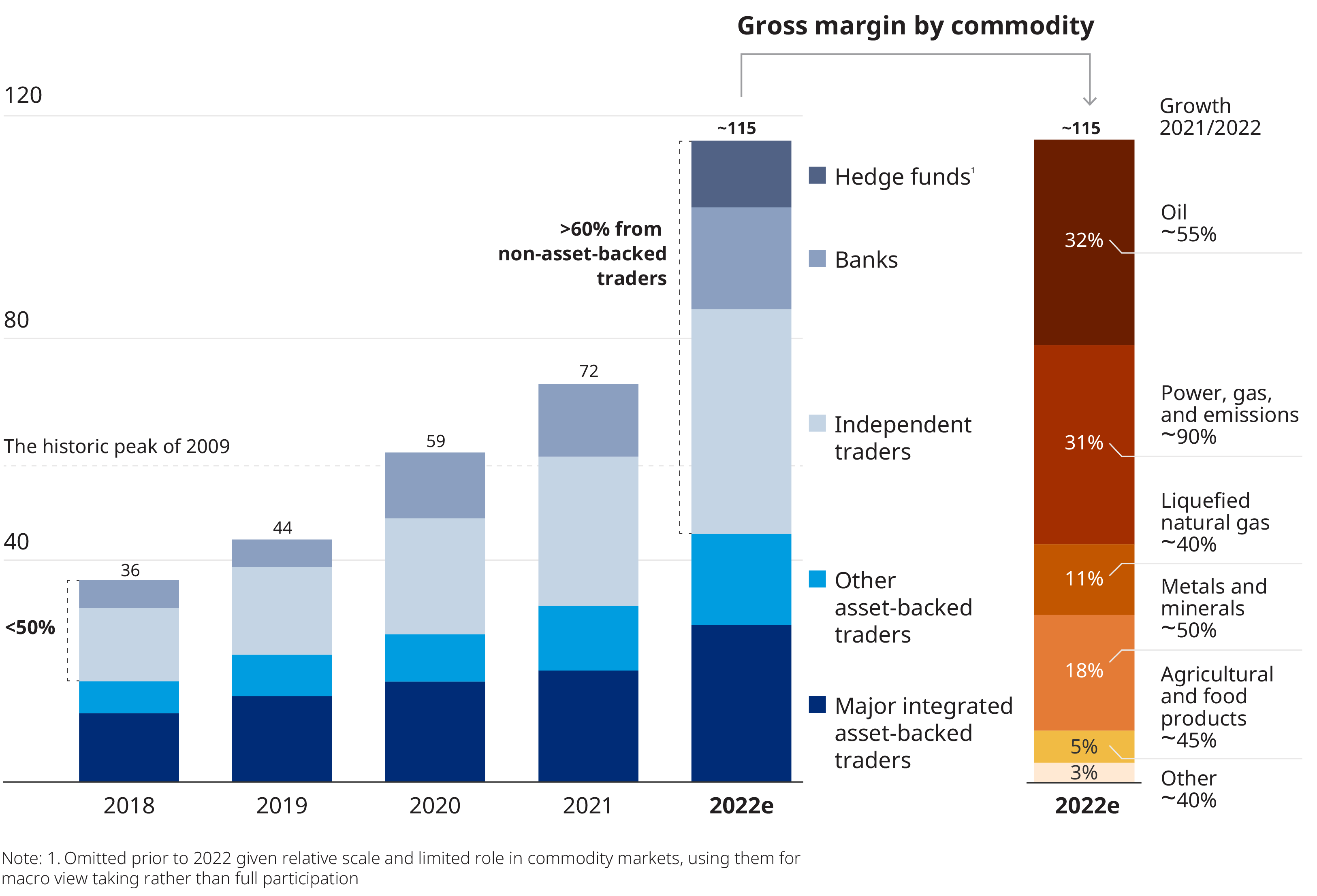Download a copy of the paper or watch a discussion with the authors here.
The commodity trading industry set an all-time record in 2022 for gross margin, surpassing $100 billion. Following record levels in 2020 and 2021, industry revenue has nearly tripled since 2018, when it was $36 billion, and has nearly doubled the $57 billion in gross margins in 2009 when markets boomed after the global financial crash (see exhibit).

Our analysis indicates that the key commodities driving the rise in trade were oil and natural gas. US and EU sanctions on Russian energy forced the country’s product to flow east rather than west and drew new sources of energy to fill the demand in Europe. To attract US oil and LNG away from Asia, prices in Europe rose, resulting in extreme prices for electricity and greater interest in renewables. This contributed to oil trading expanding 55% and power, gas, and emissions trading rising an astonishing 90%. LNG was another key performer, up around 40% as liquefied product filled in gaps where pipeline gas was not available.
And, while the industry expansion generated large growth in all trading sectors, the players that saw dramatic increases were the traditionally non-asset-backed traders – that is, independents, banks, and hedge funds. As a result, independent traders now comprise about one-third of the market.
This expansion came from four key factors that drove opportunities for traders.
The market factors supporting trading opportunities
- Dramatic volatility: Commodities markets in 2022 went beyond the normal use of the word “volatility”. With each of the many price fluctuations, traders had the opportunity to make money on the upwards and downwards movements.
- Trade flow changes: Shipping patterns changed, especially in the energy industry. Traders able to deal with these changes, redirect cargo, and find new sources and outlets differentiated themselves.
- Stable demand growth and short markets: Post-COVID economic recovery ensured demand for commodities and energy remained high throughout the year. This rise in demand overall, while supply remained tight and potentially unavailable, pushed prices and volatility higher.
- Significant increase in collateral posted and cash requirements: The demand for cash collateral rose significantly in 2022, causing some traders to abandon in-the-money positions due to lack of liquidity. Some players took this balance sheet pressure to assess the situation and drive capital efficient returns.
This made 2022 a big year for traders in every sector, but a profile emerged of the players who were prepared to seize new opportunities.
The characteristics of successful commodity traders
Two factors always explain a significant portion of the returns realized by the top commodity trading players: Size (that is, asset size, flow footprint, and amount of flexibility and optionality) and available, flexible, self-determined access to capital and cash.
However, there were three other character traits of great traders that became performance accelerators, boosting performance beyond expectations based on assets and capital. Players that have developed a culture of agility, constant evolution, and bravery saw that investment in talent come to fruition.
This year’s Commodity Trading paper provides a deep dive on the growth of the industry, exploring the key commodities that were driving trade, the different players entering the market, and what gave certain traders the competitive edge.
Christian Lins and Mark Pellerin, partners, Marc Zimmerlin, principal, and Tilman Schnellenpfeil, engagement manager, also contributed to this report.
A discussion with the team behind the paper
Partners Ernst Frankl, Alex Franke, and Mark Pellerin highlight the key findings of this year's paper on the state of the commodity trading industry.


